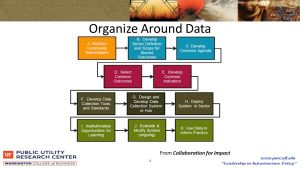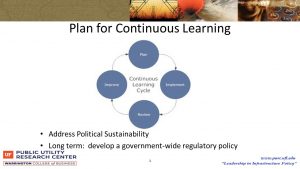Guiding Coalition – Central Coordination of Reform
Establishing Central Coordination of Reform
Create a specialist body (backbone group) to coordinate and monitor reform for advocacy, monitoring and feedback, and capacity development.
Taking initial steps:
- Recognize political challenges and opportunities
- Identify stakeholders and create an organizational architecture for reform committees
- Determine existing limitations of operators (financial management, customer care, asset management, environmental impacts, and communications)
- Investigate strengths and limitations of existing legal structure, funding, and staffing of organizations currently regulating operators

Stakeholders are likely to be distrustful of authority, so a major task is to build trust and restore social fabric. Organize around data, focus on assets and not deficits. Acknowledge that there is no “simple recipe.” Create the backbone guiding coalition, and coordinate, share accountability for implementation, review outcomes.
Developing a Regulatory Governance Policy for Infrastructure Sectors
- Establish the organizational architecture:
focus on the organization, processes, tools and norms of interaction, decision-making, monitoring and evaluation used by government organizations and their counterparts in the private sector in providing infrastructure services. - Develop an action plan:
Agree on a small number of goals/outcomes and define specific and measurable objectives for each goal - Identify strategic objectives and actions:
Develop a work plan and tracking mechanisms/accountability measures. These should be derived from a sound strategic approach to infrastructure planning that reflects clear views of how the relevant industries are expected to develop over time and what key objectives are to be achieved in the short, medium and long-term. - Establish clear roles/responsibilities:
Set out in broad terms the basic elements of the regulatory regime for infrastructure, specifying what regulatory agencies will be established and/or modified, with a clear allocation of roles between the institutions involved, providing a high degree of certainty for the various actors, whilst retaining a degree of flexibility to meet changing circumstances. - Build the backbone infrastructure (leadership and funding)
- Recruit personnel:
Leader/convener – brings key leaders to the collaborative and moves the group towards a cohesive, collective strategic direction
Director/facilitator – manages the day-to-day work to support the community collaborative; accountable for getting things done between meetings. Guides the collaborative’s meetings, with a specific eye towards moving the group to consensus and action. This person often has deep skills related to strategic planning, process improvement and/or stakeholder management.
Data analyst – supports continuous learning on the technical side by aggregating and analyzing data, find trends and reporting back to the group. Rather than build this capacity, some collaboratives partner with researchers or an outside firm to play this role.
Policy analyst – monitors policy news and changes relevant to the collaborative’s work, reports back to the group on policy wins and obstacles, and helps determine opportunities for the collaborative to have influence on policy decisions.
Administrative support – coordinates all meetings across the collaborative, ensuring that the groups are on track and committee meetings are run consistently.
Communications/development director – manages external communications to maximize the impact of the collaborative’s work; ensures that the collaborative speaks as one entity when appropriate, coordinates with partners to ensure that their independent communications are aligned with the collaborative’s agenda and maintains and develops relationships with funders. - Plan for continuous learning:
Understand the problem or issues that a collaborative is trying to address. Gain alignment around what the data is saying. Make specific decisions about the collaborative’s agenda and roadmap. Learn about what is working and not working. Track the progress against community-wide goals, using relevant metrics. Publicly highlight successes to increase community and stakeholder backing. Attract funding by showing progress.

Additional Resources: FAQ
